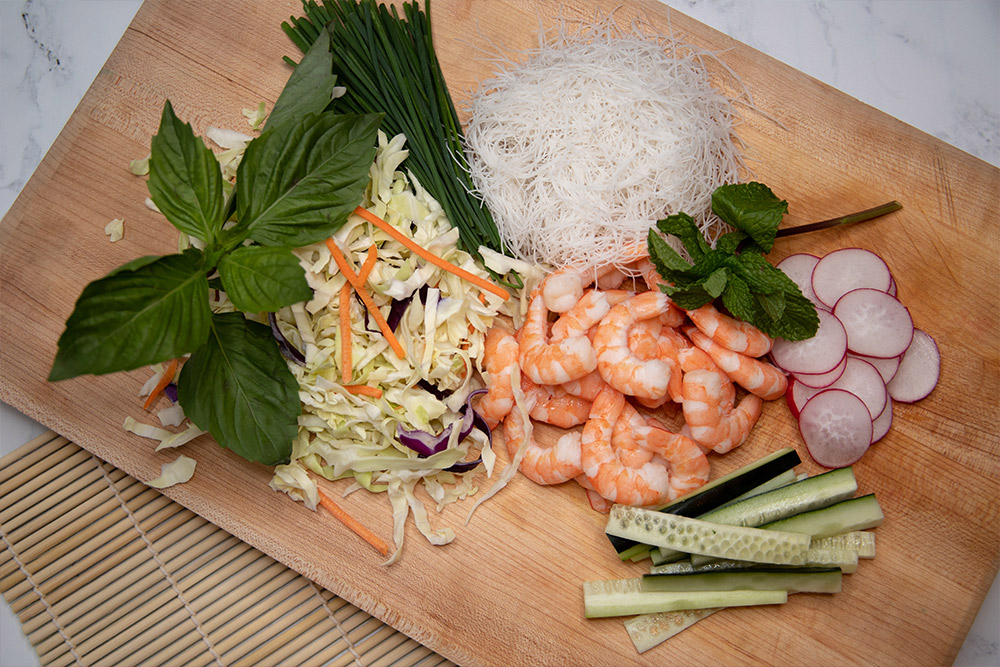Celebrate the freshness of the season with DIY spring rolls
By Amy S. White / Photography by Mary Quinn
Spring is synonymous with freshness. The world slowly but surely reawakens from its long, cold winter with sunshine and fresh air and budding gardens, and you know what? So do people. As the late, great comedian Robin Williams once said, “Spring is nature’s way of saying ‘Let’s party!’” In fact, many cultures have always celebrated spring with a party, and as any reader of this column knows, the best part of a party is the food.
Fresh spring rolls are one such festive food. They originated in mainland China during the spring festival known as Chinese New Year. Filled with seasonal spring vegetables, spring rolls are a refreshing change from the preserved foods of winter, their fresh, clean flavors creating delightfully light warm-weather fare.
The rolls we are talking about here are neither fried nor baked. While ingredients can vary by region, and they go by many names, including summer rolls, or salad rolls, spring rolls typically consist of a filling of rice noodles, a cooked protein, raw vegetables, and fresh herbs, all rolled up in a rice paper wrapper, and served with a dipping sauce.
While they do take a little bit of practice to perfect, spring rolls are extremely adaptable, versatile, and forgiving. There is no one set list of ingredients. Once you’ve purchased the rice paper wrappers and noodles (try a local Asian market if you can’t find them in the grocery store), you can use almost anything you have in your pantry or your fridge to fill them. For proteins, I like to use leftovers, usually cooked shrimp, shredded chicken, sliced pork, or tofu for a meat-free choice. One of these days, I’m going to make a version with the deliciously sweet meat found inside a lovely crab leg, maybe with a little bit of avocado!
Contrasting textures and flavors are key to creating a well-balanced spring roll. I love the scrumptious crunch you get from adding certain vegetables like shredded carrots and purple cabbage. Feeling lazy? Store-bought coleslaw mix is the hack for that. Julienne (cut into long thin slices) other veggies like cucumbers or green onions, or thinly sliced water chestnuts or radishes. Like it tangy? Try pickled vegetables. Don’t want to do any extra work? Try some bean sprouts.
Even more of that fresh flavor for which spring rolls are known comes from adding leafy herbs like Thai basil, cilantro, or mint. No matter what I put inside, I almost always dip my rolls in peanut sauce. In a pinch, a store-bought sweet-chili sauce also works well.
Let’s put tradition aside for just a quick moment and imagine a non-savory spring roll. For a sweet treat, make a fruit version! A few combinations that come to mind are berries and mint, coconut and mango, or citrus and basil. For these, you’d probably like to leave out the noodles, although it’s your party – roll how you want! Dip them in yogurt or, if you’re feeling more decadent, try whipped cream.
Sweet or savory, made with the right ingredients, spring rolls are a healthy and flavorful appetizer, light meal, or snack. Their size makes them nicely portable, easy to eat on the go, and a great snack for kids. They can be adapted to suit most diets, too! For example, leave out the noodles for fewer carbs; vegetarian and vegan versions are easy to conjure up. Since the wrappers and noodles are made from rice, these are, by nature, gluten-free.
Once you’ve decided your individual ingredients list, it becomes less about the cooking and all about the prep work. Have your protein cooked, your rice noodles (if you’re using them) soaked, your vegetables peeled and chopped, and your herbs rinsed and plucked. Put it all within reach, and then it’s time for the assembly line.
You’re going to make these one at a time, so feel free to mix it up. The ingredients in each roll can be different, if you like. If presentation matters to you, remember that whatever you put on the bottom is likely going to be what ends up being seen on top through the translucent wrapper.
Before assembling each roll, you’ll want to make the wrapper pliable by giving it a 10-second soak in a shallow dish filled with warm water.
Spring rolls are best eaten right away – remember, these are all about freshness! However, if you need to store them, wrap each roll individually in plastic wrap. The plastic wrap ensures the wrapper won’t dry out, and wrapping them individually prevents them from sticking together and tearing. Put the wrapped rolls in an airtight container in the fridge and consume within a couple of days.
So “spring” into action! Trying these DIY takeout spring rolls is a great way to usher in the spring season – one fresh, healthy, balanced bite at a time.
Amy S. White is a Connecticut teacher, writer, and line cook.









More Stories
Ashley Flagg: The Laurel
Wildcat
Dip Into Deliciousness